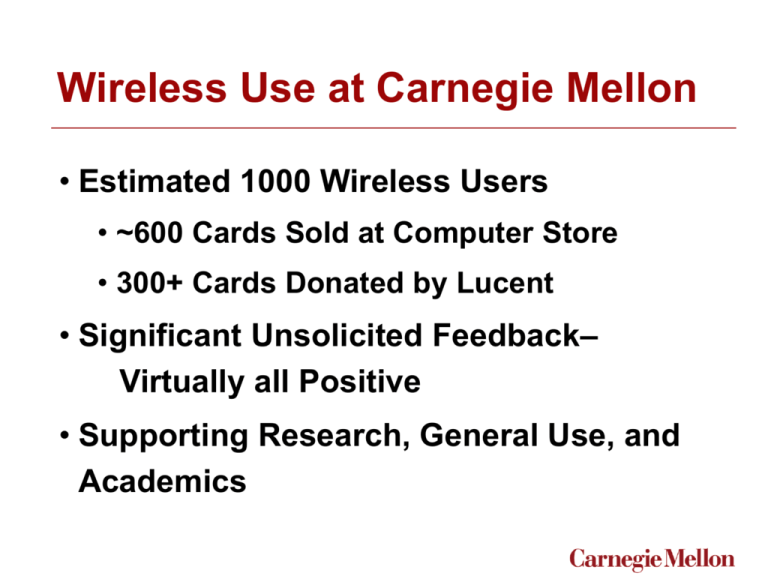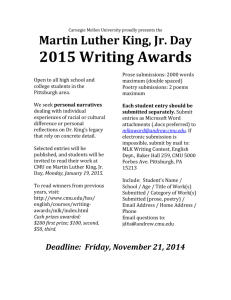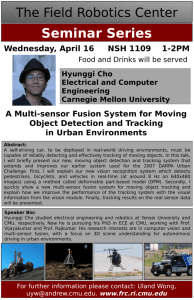Wireless Use at Carnegie Mellon
advertisement

Wireless Use at Carnegie Mellon • Estimated 1000 Wireless Users • ~600 Cards Sold at Computer Store • 300+ Cards Donated by Lucent • Significant Unsolicited Feedback– Virtually all Positive • Supporting Research, General Use, and Academics Research Interest • Original Deployment – Research Network • Supporting Faculty Efforts in • Robotics, Computer Science, Human Computer Interaction, Electrical and Computer Engineering, Information Networking, . . . . • Degree of Interdisciplinary Collaboration on Campus is Extremely High Research Projects (a partial list….) • ARC Group – (Antenna & Radio Communications) Group; Stancil, et al - www.ece.cmu.edu/wireless/ • Monarch – Adaptive Mobile & Wireless Networking; Johnson - www.monarch.cs.cmu.edu/ • Coda – Mobile Information Access; Satyanarayanan www.cs.cmu.edu/afs/cs.cmu.edu/project/coda/Web/coda.html • Wearable Computers; Siewiorek, www.cs.cmu.edu/afs/cs.cmu.edu/project/vuman/www/home.html • Aura – Pervasive Invisible Computing; Reddy, et al http://www.cs.cmu.edu/~aura/ • Industry Applications; Bennington http://www.ini.cmu.edu/WIRELESS/ Research Issues • Bleeding edge versus production support • Which standard (802.11, Bluetooth); which version (firmware, drivers, speeds…) • Stable infrastructure; Flexibility/control • Issues of airspace “ownership” • Carnegie Mellon Airspace Policy Guideline http://www.cmu.edu/computing/wireless/airspace.html • Bottom line – So long as we’re able to support their needs, faculty are thrilled we’re running the network General Interest • Beginning in 1997/98 increasing push to move from research (best effort) to production (supported) network • Graduate Business School–laptop program • Faculty & staff from various disciplines • Computing services staff using heavily • Users want email, web access in meetings, between classes, for group projects, . . . General Use • Heavy use by students, faculty and staff • Mostly used for basic communication (email, zephyr, web browsing) • Other “more interesting” uses, ones we hadn’t envisioned or tested for • Very high convenience factor associated with ‘anytime, anywhere’ network access General Use Date: Wednesday, May 03, 2000 3:38 PM -0400 From: "J. Ray Scott" <scott@psc.edu> To: crb+@andrew.cmu.edu, tf01+@andrew.cmu.edu, poepping@andrew.cmu.edu Subject: Wireless Well, it's a long way from the days of signing up for time on the teletype pool in Science Hall 5202! My guys were busting for a) the wireless to be up in this building, b) me to buy them some PCMCIA cards, and c) the Pittsburgh Spring weather to cooperate. Today was finally the day when it all came together. Now, I still need to figure out if we're more productive than when we had the teletypes. It's an open question! :-) J Ray General Issues • Competition for attention in meetings • Increasingly used in lieu of traditional network (at least for some of us) • Mobility & scaling (single subnet now) • Only cost to user is card purchase • promote use, recognize costs, upgrade service • Bottom line – As supplement to the wired network, huge success Academic Interest • Support lab style use in classrooms • All classrooms w/ projection, video, network, etc; not all students w/ computer • Enhance communication outside class • Increase interaction between instructor and students in large courses • Support student software development projects on mobile computers Academic Projects – Wireless Four classes in Business Administration program – “Virtual Cluster” experiment • Department proposed laptop ownership; but was rejected at university level. • Challenge: find a way to supplement rather than require laptop ownership • Solution was 30 laptops w/ wireless, checked out in the 10 minute window between classes and used in traditional classroom. And it worked…. Virtual Cluster Evaluation Student survey (didn’t meet-met-exceed): • Checkout (0%-19%-81%); in (0%-14%-86%) • Hours (24%-52%-24%) • Visio (6%-50%-44%) • Email (5%-35%-60%) • Web (5%-29%-66%) • File/print (0%-56%-44%) • 95% used in class, 57% for every class; 67% used outside class Virtual Cluster Evaluation (2) Faculty feedback (most active: Software Analysis & Design; used CASE tool in class) • “It was a good pilot. Students were engaged.” • Early bandwidth issues resolved by week 3 • “Didn’t try to police them. They know I don’t relecture so if they miss it, it’s too bad.” • Intent is to repeat (and expand) next year • “I’ll get more creative” - more sophisticated exercises; collaborative work or exchanging work across teams Handheld Andrew Project • Build on wireless & system infrastructure • Enable handheld devices as full peers on the network; focus on groupware applications (email, calendar, zephyr) • Funded by a grant, not operating funds • Hardware grants for classroom use • 300 HP Jornadas, 300 Lucent cards Academic Projects – Wireless+Handheld • Wireless + Handheld • Modern Chemistry – Lecture course, 100 students; concept test delivered using Pebbles software (research project) • Rapid Prototyping and Design – Software project course; student groups developed applications for handhelds • Information Systems – System design project course; utilize web-based communication tool for teams Handheld Class Use Evaluation • Student survey (both classes) • 20% used daily, another 48% few x/week • 75% used concept test, 46% web, 43% email, 40% games (<10% other uses) • 91% classroom, 48% study area, 37% lounge, 25% cluster; 25% dining, + outside • 43% believe that handhelds will eventually be used widely in courses; 39% believe will be useful outside but not in class; Handheld Use Evaluation (2) • Of 91% who used in the classroom: • 12% - neither positive or negative impact • 22% - impact was exclusively positive • 66% - characterized impact as both + and positive and negative • For the students using concept tests: • 96% agree/strongly agree: concept tests are a useful part of the lecture • 65% a/sa: liked handhelds for concept tests because others couldn’t see response • 61% yes: should use next year Academic Issues • Can be a distraction; no reasonable way to “shut off” the network access • Mandate only for class (where do notes fit)? • Something else for students to worry about • Bottom line – Students neutral to positive; faculty go with student assessment. Big issue is whether we can/should support it or stop it. Are we just an MP3/browser/ email reader away from seeing 90% adoption rate? Final Thoughts Questions? Other Experiences to Relate Discussion….







